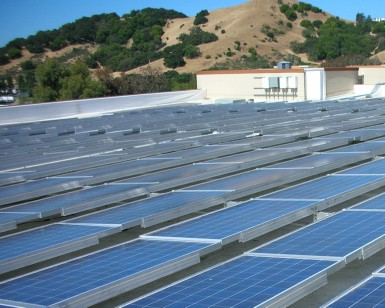San Rafael, CA – Are you serious about sustainability? Eager to see hard evidence on how we’re doing on the “green” scorecard? Newly compiled statistics are ripe for datamining on Marin County Open Data.
 The County is eager to reduce consumption of fossil fuels. This is a solar array on the roof of a County-owned building in San Rafael.
The County is eager to reduce consumption of fossil fuels. This is a solar array on the roof of a County-owned building in San Rafael.The County of Marin has released facts and figures about electricity and natural gas use, greenhouse gas (GHG) emissions, and photovoltaic installations to show how the County, towns, and cities are progressing toward shared sustainability goals. The information is for 2005 to 2015 and broken out by jurisdiction. The 2016 data is collected and will be updated on Marin County Open Data sometime this summer.
The top takeaway? The data shows that across cities and towns in Marin, greenhouse gas emissions have fallen since 2005, showing that our population is wary and conscious of climate change and willing to act. This mirrors trends shown of per capita energy use decreasing and photovoltaic installations increasing over time.
The data represents countywide collaboration on tracking progress toward Climate Action Plan goals locally. The source of this data is the Marin Climate and Energy Partnership (MCEP), which includes the County government, all of Marin’s cities and towns, the Marin General Services Authority, the Transportation Authority of Marin, MCE Clean Energy, and the Marin Municipal Water District. MCEP allows for the sharing of resources and secures funding to discuss, study and implement overarching policies and programs, ranging from emission reduction strategies to adaptation, contained in each agency's Climate Action Plan.
Supervisor Damon Connolly, the Board of Supervisors President, said public analysis of the data is the perfect follow-up to the eye-opening April 17 public workshop on sustainability and the sold-out Drawdown:Marin event in October 2017. One of the first public uses of Marin County Open Data was in April 2017 when the County hosted its first hackathon for students. At the Hack4Health event, participants downloaded raw data to devise technical solutions to health challenges that could benefit residents of Marin.
“As we learned from Hack4Health last year, when we turn the community loose with a vast amount of data that is collected, the community comes up with innovative apps to synthesize the data and make it accessible,” Connolly said. “We need all hands on deck in assessing and adapting to climate change and sequestering carbon.
“I’m excited that this data is being made available. With everyone working together, including our technology sector, analysts, and developers, we are moving in the right direction. I’m hopeful the data’s availability will expand the audience of who is paying attention to climate change. The analysis will feed directly into our Drawdown:Marin campaign to dramatically reduce our greenhouse gas emissions and become the first fossil-free county.”
Much more information about the County’s Climate Action Plan and the grassroots Drawdown:Marin movement can be found on the Climate and Adaptation webpage.
Marin County Open Data, launched a year ago, features data sets ranging from emergency medical response rates to food safety inspection results to kindergarten immunization rates. The goal is to share data, start conversations, foster analysis and discuss potential solutions to the hot-button issues. The data archive was created by the staff of the County’s Department of Information Services and Technology (IST) and can be accessed quickly at data.marincounty.org. IST personnel have been working to enhance access to information and self-service for several years and is eager to engage with the local software development community about the most effective ways to use the information.
“By hosting this information online, the County is bolstering its collection of analytics and reports that will help residents learn more and collaborate to solve issues in the community,” said Wesley Hill, County Principal Systems Analyst.
The roots of the data-sharing effort are traced to the Marin County Board of Supervisors’ 5 Year Business Plan, approved in October 2015, which included a vision of being a more responsive government with innovation as a core value. One strategy is to increase online options for the community to conduct business with the County or learn more about the services it provides.